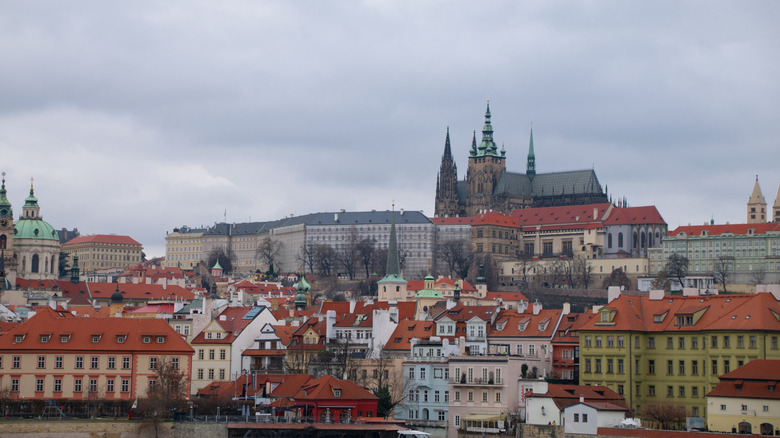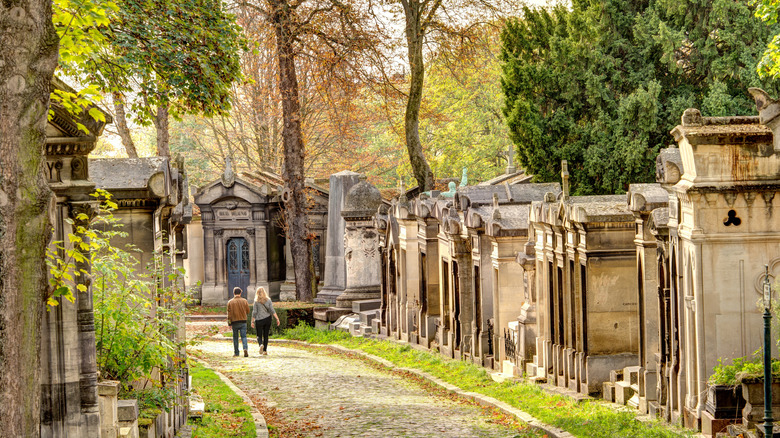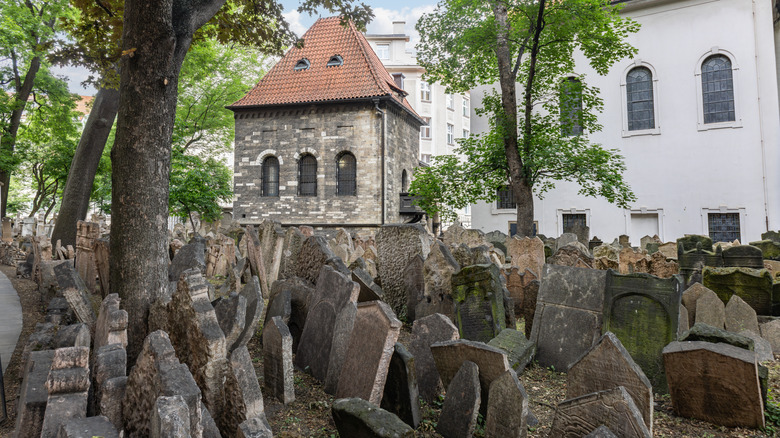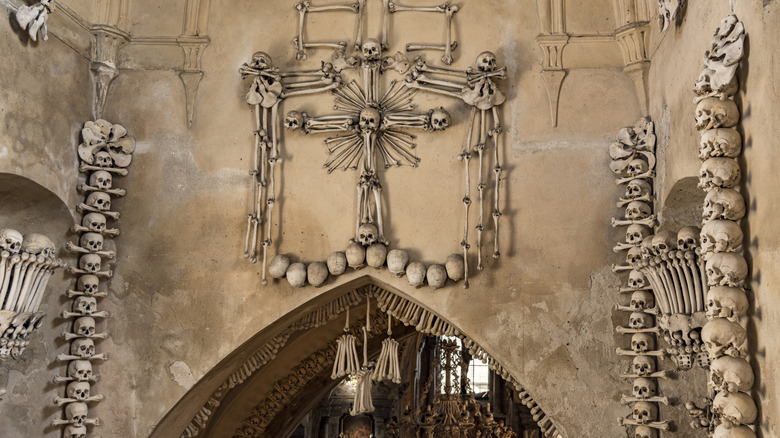The Type Of Attraction Rick Steves Recommends If You Want To See The 'Macabre Side Of Europe'
There's an entire genre of travel designed to attract tourists intrigued by the more macabre side of life, and Europe isn't immune to this. From Jack the Ripper tours in London to the requisite torture museums in nearly every medieval European town, travelers hoping for spooky vibes won't find a shortage of things to do. Famed European travel expert Rick Steves, however, recommends you avoid these "hokey rip-offs" (especially the torture museums) and seek out the ubiquitous spooky spots that make up some of the most haunted destinations in the world: cemeteries. As Steves notes on his website, cemeteries throughout Europe are "authentic, artsy, and oozing with history," perfect for a taste of the "macabre side of Europe."
Another great thing about Europe's cemeteries is the sheer volume and variety. You'll find Italian mausoleums overlooking the Mediterranean or underground in the Roman catacombs; sleepy, overgrown Irish burial grounds with mossy gravestones; elaborate tombs designed for literal kings; and plots of land crammed full of crooked stones, emblematic of the struggles of the Jewish people throughout the continent. Some are in near-ruined states, and some are still visited often, as seen in lanterns, candles, and other recent tributes. Wherever you go, in every corner of Europe, you'll find a cemetery that not only gives you a window into the past but also into the rituals and customs of the living.
Europe's best cemeteries, according to Rick Steves
Some of Europe's biggest cities have some truly spectacular cemeteries, some of which Rick Steves highlights on his website. The Père Lachaise in Paris, France, is — in true Parisian fashion — massive, elegant, historical, and somehow quintessentially French. A person could spend hours walking the cobblestone paths, discovering among some 70,000 graves and monuments the final resting spots of greats like Jim Morrison (of The Doors) and Oscar Wilde. In Milan, Italy, Monumental Cemetery seems more like an art museum, full of important sculptures and masterpiece paintings. As Steves says, the site is "Europe's most artistic and dreamy cemetery experience ... It's a vast garden art gallery of proud busts and grim reapers, heartbroken angels and weeping widows, too-young soldiers and countless old smiles, frozen on yellowed black-and-white photos."
London's Highgate Cemetery was once the burial ground for wealthy Londoners at the end of the 19th century and has amassed quite a few urban legends over the years, along with a dead celebrity or two. A tour is worth the investment, as Highgate can feel like a maze of headstones, grass, and dirt paths.
The Roman Catacombs are well known around the world and are among the most haunted destinations in all of Italy. However, Steves recommends skipping the Appian Way section where most tourists tend to visit and instead heading to the quieter, and no less authentic (not to mention eerie), Catacombs of Priscilla. And, finally, Steves hails the Kaisergruft in Vienna, where the remains of members of the Habsburg dynasty are entombed. Well, partially — their hearts and entrails were removed and preserved elsewhere. The rest of their remains are in the Kaisergruft, in impressive tombs still graced with flowers by visitors and Viennese locals.
More beautiful, unique, and intriguing European cemeteries
There are many other smaller or less well-known cemeteries throughout Europe. The Jewish cemeteries in Eastern Europe are always beautiful, although tragic. Prague's Old Jewish Cemetery, located in the Jewish Quarter, is a plot crammed with gravestones askew, all nearly on top of each other. Near Krakow's New Jewish Cemetery, there's a wall of shattered tombstones, destroyed by German soldiers during the war, now melded together in a sobering tapestry.
Some of the most picturesque cemeteries can be found on the British Isles. In the shadow of Stirling Castle in Stirling, Scotland, one of the best European countries for ghostly walks and great scares, lies the beautiful Valley Cemetery. Meanwhile, fans of Harry Potter will enjoy finding familiar names in Edinburgh's Greyfriars Kirkyard graveyard. Ireland is full of half-ruined cemeteries in the shadows of rotting churches, some buried by island sand and others covered in green moss and overgrown by green grass. England, too, has its fair share of grassy cemeteries that bloom in the spring, some near small country churches and others spreading across misty moors.
Exploring Europe beyond cemeteries
Outside of cemeteries, there are other authentic sites one can visit to experience Europe's macabre side. Some are undoubtedly designed to enhance tourism but still remain a worthwhile stop. Explore the Sedlec Ossuary in Kutna Hora, Czechia. What appears on the outside to be an unassuming chapel hides thousands of bones, arranged to form a ceiling chandelier and other sculptures, on the inside. In the hills above Austria's picturesque mountain town of Hallstatt, visit the painted skulls in the Hallstatt Bone House, and in Évora, Portugal, venture inside the Capela dos Ossos (Chapel of Bones). And then there's Transylvania in Romania, an underrated region in Europe to visit for a hauntingly beautiful getaway, with its legendary castles and mysterious forests.
Although many ghost tours are tourist traps, there are plenty of buildings in Europe that are reputed to be haunted, such as countryside chateaux, historic alleyways, former prison islands, and ancient castles. Even skeptics might start to believe when they feel a little ghost child take their hand in the vaults of Edinburgh or feel the hot breath of a witch condemned to die at Moonsham Castle near Salzburg.



